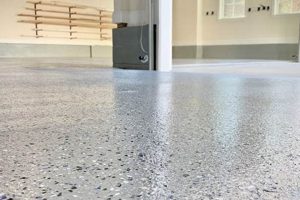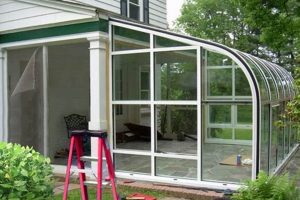A collection of components that enables enthusiasts to assemble their own first-person view (FPV) aircraft is defined by the phrase. This typically encompasses the frame, motors, electronic speed controllers (ESCs), flight controller, camera, video transmitter (VTx), receiver, and necessary wiring. As an example, a user may purchase a package containing all these parts, building and configuring the drone themselves instead of buying a pre-assembled unit.
The significance lies in the educational value, customization options, and cost-effectiveness it offers. The process of building promotes a deeper understanding of drone technology, troubleshooting skills, and the ability to tailor the aircraft’s performance to specific needs. Historically, constructing these aircraft from individual parts was the only option; packaged sets simplify the process, making it more accessible to a broader audience. This allows individuals to repair and upgrade their aircraft without relying on manufacturers.
Subsequent sections will detail the selection criteria for components, the assembly process, essential safety considerations, and potential applications of these custom-built FPV platforms.
Essential Guidance for Assembling a First-Person View Aircraft
The following recommendations provide critical insights for successful construction and operation. Adherence to these guidelines will mitigate potential risks and enhance performance.
Tip 1: Component Compatibility is Paramount: Verify the compatibility of all components prior to purchase. Mismatched voltage ratings or incompatible communication protocols can lead to system failure or damage. For instance, ensure that the ESCs are rated for the voltage supplied by the battery and that the flight controller supports the ESC protocol.
Tip 2: Prioritize Quality Soldering: Secure, clean solder joints are essential for reliable electrical connections. Cold solder joints introduce resistance, causing voltage drops and intermittent signal loss. Employ a quality soldering iron and appropriate solder for electronics applications.
Tip 3: Implement Proper Wire Management: Organized wiring prevents shorts and interference. Utilize heat shrink tubing and cable ties to secure wires and keep them away from rotating components. This also simplifies troubleshooting and maintenance.
Tip 4: Calibrate ESCs Accurately: Proper ESC calibration ensures that all motors respond uniformly to throttle commands. Failure to calibrate can result in uneven motor speeds and unstable flight characteristics. Follow the manufacturer’s calibration procedure meticulously.
Tip 5: Configure the Flight Controller Thoroughly: The flight controller dictates the aircraft’s flight behavior. Take time to understand and configure the PID settings, flight modes, and receiver inputs. Incorrect configuration can lead to erratic or uncontrollable flight.
Tip 6: Verify Failsafe Operation: Failsafe functionality ensures that the aircraft behaves predictably in the event of signal loss. Configure the failsafe to either land the aircraft or hover in place. Testing the failsafe is crucial before the first flight.
Tip 7: Perform Pre-Flight Checks Methodically: Before each flight, inspect the aircraft for loose screws, damaged propellers, and secure battery connections. A comprehensive pre-flight check minimizes the risk of mechanical failure during flight.
These guidelines represent fundamental principles for the construction and operation of custom FPV aircraft. Diligent application of these practices promotes safety and optimizes performance.
The concluding section will summarize the benefits of building an FPV drone and outline future trends in the field.
1. Component Selection
Component selection constitutes a foundational stage in the construction of an unmanned aerial vehicle from a “diy fpv drone kit”. The choice of each individual component directly impacts the final performance, durability, and operational characteristics of the assembled aircraft. For example, the selection of high-kV motors paired with inappropriately sized propellers can lead to excessive current draw, resulting in reduced flight time and potential damage to the electronic speed controllers. Conversely, underpowered motors may struggle to lift the aircraft, compromising maneuverability and stability.
The interdependence between components necessitates a holistic approach to selection. The frame size dictates the maximum propeller diameter and motor mounting pattern. Battery capacity and voltage must be compatible with the motor and ESC ratings. The flight controller must support the chosen receiver protocol and offer sufficient processing power for the desired flight modes. An inadequate video transmitter power output limits the transmission range, while a low-resolution camera affects the clarity of the FPV feed. A real-world example is choosing a flight controller without a barometer for altitude hold, severely impacting the performance of autonomous missions in environments lacking GPS signal.
Therefore, informed component selection is crucial for realizing the intended functionality and performance of a custom-built FPV drone. Failure to adequately consider the interplay between individual components can result in a sub-optimal, unreliable, or even non-functional aircraft. Understanding these relationships minimizes potential pitfalls and maximizes the likelihood of a successful build and operational experience. Furthermore, it allows for optimization based on the intended application, be it racing, freestyle acrobatics, or aerial photography.
2. Frame Construction
Frame construction represents a critical element within the assembly of a first-person view (FPV) aircraft utilizing a “diy fpv drone kit”. The frame serves as the structural backbone, housing and protecting all other electronic components. Its design and material composition directly influence the drone’s weight, aerodynamic properties, and crash resistance. For example, a frame constructed from lightweight carbon fiber offers a high strength-to-weight ratio, enhancing agility and flight time, while a more robust frame made of thicker material can withstand more severe impacts, albeit at the cost of increased weight. Inadequate frame design can lead to vibrations, instability, and premature component failure, as seen when mounting motors on thin arms that flex during flight.
The selection of frame geometry also dictates the propeller size and motor placement, thereby affecting thrust vectoring and overall maneuverability. For instance, a ‘dead cat’ frame, with angled front arms, minimizes propellers appearing in the camera’s field of view, beneficial for aerial photography. An H-frame provides a balanced weight distribution, suitable for general-purpose flying. X-frames are commonly favored for racing due to their symmetrical design and responsive handli
ng. Practical application involves considering the intended use-case; a long-range drone might utilize a larger frame to accommodate larger batteries, while a smaller, more compact frame is better suited for navigating tight spaces. Choosing the wrong material, such as using 3D-printed plastic in high-stress areas, would result in rapid frame failure.
Therefore, frame construction directly impacts the performance, reliability, and suitability of an FPV aircraft built from a “diy fpv drone kit”. Understanding the relationship between frame design, materials, and component placement is paramount for achieving the desired flight characteristics and ensuring the longevity of the aircraft. Overlooking these considerations introduces vulnerabilities and limits the drone’s potential. A well-executed frame facilitates optimal component integration and contributes significantly to the overall success of the build.
3. Soldering Precision
Soldering precision represents a non-negotiable aspect within the assembly process of a first-person view (FPV) aircraft utilizing a “diy fpv drone kit”. Its significance extends beyond mere component attachment, influencing the overall electrical integrity, performance reliability, and operational safety of the assembled platform. Inadequate soldering can introduce a cascade of issues, from intermittent signal loss to catastrophic system failure.
- Electrical Conductivity and Resistance
Proper soldering establishes a low-resistance electrical pathway, ensuring efficient current flow to all components. Cold solder joints, characterized by a dull appearance and incomplete wetting of the joint, introduce increased resistance, leading to voltage drops and potential component overheating. This can manifest as reduced motor power, diminished video transmission quality, or even flight controller malfunction. For instance, a poorly soldered connection on a battery lead can cause significant voltage sag under load, leading to unexpected crashes.
- Mechanical Strength and Durability
A secure solder joint provides mechanical strength, preventing components from detaching during flight or upon impact. Vibration and G-forces experienced by an FPV drone place considerable stress on solder joints. Insufficient solder or improper technique can result in brittle joints that fracture easily. For example, a fragile solder joint connecting a motor to an ESC can break mid-flight, causing a motor to stop and the drone to plummet.
- Signal Integrity and Noise Reduction
Precise soldering minimizes unwanted electrical noise and interference, particularly in sensitive circuits such as the video transmission system. Inconsistent solder joints can act as antennas, picking up stray electromagnetic radiation. This can degrade the quality of the video feed, resulting in static, distortion, or complete signal loss. Shielding wires and ensuring clean, concise solder joints are crucial for maintaining signal integrity.
- Long-Term Reliability and Maintenance
High-quality soldering ensures long-term reliability and simplifies future maintenance. Well-executed solder joints resist corrosion and oxidation, maintaining their electrical and mechanical properties over time. Conversely, poorly soldered joints are prone to degradation, requiring frequent inspection and repair. Clean, accessible solder joints also facilitate component replacement and troubleshooting. Conversely, poorly soldered connections make disassembly challenging and can even damage components.
These facets highlight the critical role of soldering precision in the successful construction and operation of an FPV aircraft from a “diy fpv drone kit”. Compromising on soldering quality inevitably translates to compromised performance, reliability, and safety. Mastery of soldering techniques and meticulous attention to detail are therefore essential skills for any aspiring drone builder.
4. Flight Controller Configuration
Flight controller configuration represents a pivotal stage in the assembly and operational readiness of a first-person view (FPV) aircraft constructed from a “diy fpv drone kit”. The flight controller serves as the central processing unit, interpreting pilot inputs, stabilizing the aircraft, and managing various onboard sensors and systems. Its configuration dictates the aircraft’s flight characteristics, responsiveness, and overall performance profile.
- PID Tuning
Proportional-Integral-Derivative (PID) tuning involves adjusting control loop parameters to optimize the aircraft’s stability and responsiveness. Incorrect PID settings can lead to oscillations, overcorrections, or sluggish handling. For instance, overly aggressive P-gain can cause rapid oscillations, while insufficient I-gain can result in drift or inability to maintain a stable hover. The values are often adjusted through trial-and-error, or by using automated tuning tools within the flight controller software.
- Receiver Configuration
Receiver configuration involves mapping the radio receiver channels to corresponding flight control inputs, such as throttle, roll, pitch, and yaw. The selected protocol, such as PWM, PPM, or serial protocols like SBUS or iBus, must be correctly configured for communication between the receiver and the flight controller. Incorrect channel mapping or protocol selection will result in unresponsive or unpredictable aircraft behavior.
- Flight Mode Setup
Flight mode setup defines the operational modes available to the pilot, such as angle mode (self-leveling), acro mode (full manual control), and horizon mode (hybrid of angle and acro). Each mode offers different levels of assistance and control authority. Assigning specific switches or stick positions to activate these modes allows the pilot to tailor the aircraft’s behavior to their skill level and the flying environment.
- Sensor Calibration
Sensor calibration involves compensating for inherent biases and offsets in onboard sensors, such as the accelerometer, gyroscope, and magnetometer. Calibration ensures accurate sensor readings, which are essential for stable flight and reliable autonomous functions. Failure to calibrate these sensors can result in drift, instability, and inaccurate position estimation.
These multifaceted configurations illustrate the critical role that the flight controller plays in defining the flight characteristics of an FPV aircraft built from a “diy fpv drone kit”. Understanding and appropriately configuring these parameters is essential for achieving the desired performance and ensuring a safe and enjoyable flying experience. Overlooking or improperly implementing any of these aspects significantly compromises flight capabilities and introduces operational risks.
5. Video Transmission Setup
Video transmission setup forms a crucial subsystem within any first-person view (FPV) aircraft assembled from a “diy fpv drone kit”. It enables the pilot to remotely perceive the drone’s surroundings in real-time, facilitating navigation, maneuvering,
and task completion. A properly configured and optimized video transmission system is paramount for a successful and immersive FPV experience.
- Component Selection and Compatibility
The selection of components, including the camera, video transmitter (VTx), and receiver (VRx), dictates the overall performance and range of the video transmission system. Ensuring compatibility between these components is critical. For instance, selecting a VTx with a power output exceeding the legal limits in a given jurisdiction can result in interference and regulatory penalties. Similarly, choosing a VRx that is not compatible with the VTx’s frequency band will prevent the reception of the video signal. A practical example includes matching the camera’s video output format (NTSC or PAL) with the VTx’s encoding capabilities.
- Frequency Band Selection and Regulations
The operating frequency band plays a significant role in transmission range, signal penetration, and susceptibility to interference. The 5.8 GHz band is commonly used for FPV video transmission due to its balance between range and bandwidth. However, other frequency bands, such as 1.3 GHz, offer improved penetration but may be subject to stricter regulations. Understanding and adhering to local regulations regarding frequency usage and transmission power is essential to avoid legal issues and ensure responsible operation. Utilizing unauthorized frequencies can lead to interference with other critical communication systems.
- Antenna Optimization and Polarization
Antenna selection and placement significantly impact the signal strength and range of the video transmission system. High-gain antennas offer increased range but may have a narrower beamwidth, requiring more precise aiming. Understanding antenna polarization (linear vs. circular) is also crucial. Mismatched polarization between the VTx and VRx antennas results in significant signal loss. Implementing diversity receiver systems with multiple antennas improves signal reliability by mitigating the effects of signal fading and multipath interference. Example: Using a cloverleaf antenna on the VTx and a patch antenna on the VRx to maximize signal strength and minimize interference.
- Power Filtering and Interference Mitigation
Power filtering and interference mitigation techniques are essential for achieving a clean and stable video signal. Noise from the drone’s power system can interfere with the video signal, resulting in static, lines, or complete signal loss. Employing LC filters and shielded cables minimizes noise and improves video quality. Separating the video transmission system’s power supply from the motor power supply can further reduce interference. Consider adding ferrite rings and ensuring good grounding practice.
These elements are indispensable for constructing a reliable and high-performing video transmission system within a “diy fpv drone kit”. Careful consideration of each component’s specifications, regulatory compliance, and effective implementation of noise reduction techniques are pivotal for achieving a clear and immersive FPV experience. Overlooking these considerations results in a compromised video signal, limiting the pilot’s situational awareness and potentially jeopardizing the safe operation of the aircraft.
6. Power System Integration
Power system integration constitutes a critical aspect of assembling a first-person view (FPV) aircraft utilizing a “diy fpv drone kit”. The integration encompasses the selection, configuration, and interconnection of components responsible for providing electrical power to all onboard systems. Its effectiveness directly impacts the drone’s flight time, performance, and operational reliability.
- Battery Selection and Capacity
The selection of the appropriate battery chemistry, voltage, and capacity is paramount. Lithium Polymer (LiPo) batteries are commonly employed due to their high energy density and discharge capabilities. The battery’s voltage must be compatible with the voltage requirements of all other components, while the capacity (measured in mAh) determines the flight time. Inadequate battery capacity results in shortened flight durations, while exceeding the maximum discharge rate can damage the battery and compromise safety. Example: Utilizing a 4S (14.8V) LiPo battery with a capacity of 1500mAh in a racing drone configuration allows for approximately 3-5 minutes of aggressive flight, while a larger 2200mAh battery extends flight time but increases the drone’s overall weight.
- Electronic Speed Controller (ESC) Compatibility
Electronic Speed Controllers regulate the power delivered to the brushless motors, controlling their speed and direction. The ESCs must be appropriately sized to handle the maximum current draw of the motors. Insufficient ESC amperage rating leads to overheating and potential failure, while oversized ESCs add unnecessary weight. Example: Selecting 30A ESCs for motors that draw a maximum of 25A ensures adequate headroom and prevents ESC failure under peak load conditions. Proper communication protocol such as DShot or Multishot is crucial for optimal motor control.
- Power Distribution Board (PDB) or Flight Controller Integration
The Power Distribution Board distributes power from the battery to the various components, including the ESCs, flight controller, and video transmitter. PDBs often include voltage regulators to provide stable power to sensitive components. Some flight controllers incorporate a built-in PDB, simplifying wiring and reducing weight. Ensuring proper wiring gauge and soldering techniques is essential to prevent voltage drops and ensure reliable power delivery. Example: Employing a PDB with integrated BEC (Battery Elimination Circuit) to provide a regulated 5V output for powering the flight controller and receiver.
- Wiring and Connector Integrity
The integrity of the wiring and connectors is crucial for maintaining a stable and reliable power system. Using appropriately sized wiring gauge for the current being carried minimizes voltage drops and prevents overheating. Secure and properly insulated connectors prevent short circuits and ensure reliable connections. Inspecting wiring and connectors regularly for damage or corrosion is essential for maintaining system integrity. Incorrectly polarized connectors or poor soldering can lead to irreversible damage and operational failures. Example: Employing XT60 connectors for the battery connection due to their ability to handle high current loads and provide a secure connection.
These multifaceted aspects of power system integration highlight its significance in the successful operation of an FPV aircraft built from a “diy fpv drone kit”. A well-designed and implemented power system ensures stable voltage, adequate current delivery, and reliable operation, contributing directly to the drone’s flight performance and longevity. Conversely, a poorly integrated power system introduces vulnerabilities and significantly increases the risk of component failure and operational mishaps.
7. Safety Protocols
Safety protocols are intrinsic to the responsible construction and operation of any first-person view (FPV) aircraft, particularly those originating from a “diy fpv drone kit.” The inherent nature of these kits, requir
ing user assembly and configuration, necessitates a thorough understanding and adherence to safety guidelines to mitigate potential risks. Failure to implement proper safety protocols directly increases the likelihood of equipment damage, personal injury, or property damage. For instance, neglecting to properly balance propellers can result in excessive vibrations, leading to component failure and potentially causing the drone to become unstable during flight.
A crucial aspect of safety protocol implementation involves pre-flight inspections. This includes verifying propeller integrity, ensuring secure battery connections, and confirming proper motor operation. Prior to powering up the aircraft, it is imperative to establish a clear flight path, free from obstructions and bystanders. Furthermore, understanding and abiding by local regulations regarding drone operation, including altitude restrictions and prohibited airspace, is paramount. A practical example of this involves checking for power lines or other obstacles before take-off, to avoid collisions which could result in serious damage or injury.
The construction and operation of drones from “diy fpv drone kits” present unique challenges related to safety. Rigorous adherence to established safety protocols is essential to minimizing risk and ensuring responsible use. Neglecting these protocols not only endangers individuals and property but also contributes to a negative perception of the hobby, potentially leading to increased regulation. Promoting a culture of safety within the FPV community is therefore crucial for its continued growth and responsible participation.
Frequently Asked Questions
The following elucidates common inquiries regarding the assembly and utilization of custom FPV aircraft.
Question 1: What specific tools are indispensable for assembling a “diy fpv drone kit”?
A soldering iron with temperature control, precision screwdrivers, wire strippers, wire cutters, multimeter, heat gun (or lighter) for heat shrink tubing, and zip ties for cable management constitute the essential toolkit.
Question 2: How does one ascertain the compatibility of components within a “diy fpv drone kit” prior to assembly?
Consult component datasheets for voltage ratings, current handling capabilities, communication protocols (e.g., SBUS, PWM, DShot), and physical dimensions. Verify that the flight controller firmware supports the selected components and protocols. Online compatibility checkers may also be available.
Question 3: What measures mitigate the risk of electrical short circuits during the assembly of a “diy fpv drone kit”?
Employ heat shrink tubing to insulate exposed solder joints, meticulously manage wiring to prevent abrasion or contact with conductive surfaces, and thoroughly inspect all connections for potential shorts prior to powering the system.
Question 4: How does one calibrate the Electronic Speed Controllers (ESCs) in a “diy fpv drone kit” to ensure synchronized motor operation?
The specific calibration procedure varies depending on the ESC and flight controller. Generally, this involves entering a calibration mode within the flight controller software and cycling the throttle range to establish the minimum and maximum PWM (Pulse Width Modulation) values.
Question 5: What regulatory considerations govern the operation of a “diy fpv drone kit” in various jurisdictions?
Regulations vary significantly by region. Generally, adherence to maximum altitude limits, prohibitions against flying near airports or restricted airspace, requirements for registration or licensing, and restrictions on night flying are common. Consultation with local aviation authorities is advised.
Question 6: What are the recommended safety precautions for operating an FPV aircraft constructed from a “diy fpv drone kit”?
Pre-flight inspections are crucial. Never operate the aircraft near people, animals, or property. Maintain visual line of sight if required by local regulations. Understand failsafe mechanisms. Adhere to established safety guidelines and best practices to minimize risks. A spotter is highly recommended for all flights, especially for beginners.
These points should serve as a foundation for those delving into the complexities of these customized platforms.
Next, the article will investigate potential advancements within “diy fpv drone kit” technology, along with future projections.
DIY FPV Drone Kit
The preceding sections have explored critical facets pertaining to the assembly and operation of first-person view aircraft from component collections. Emphasis has been placed on component selection, soldering precision, flight controller configuration, video transmission setup, power system integration, and adherence to rigorous safety protocols. Understanding each of these elements facilitates the construction of robust and high-performing FPV drones, enabling users to tailor their aerial platforms to specific applications and performance requirements.
As technology progresses, opportunities for further innovation within individual component selection expand. Continued exploration of more complex and advanced systems integration and thorough attention to responsible and safe operation of these aircraft remains crucial. The users thorough understanding of all components provides a robust and reliable foundation for this rapidly evolving technology.







